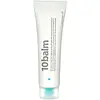What's inside
What's inside
 Key Ingredients
Key Ingredients

No key ingredients
 Benefits
Benefits

 Concerns
Concerns

 Ingredients Side-by-side
Ingredients Side-by-side

Water
Skin ConditioningC13-15 Alkane
SolventGlycerin
HumectantHydrogenated Polyisobutene
EmollientPolyglyceryl-3 Polyricinoleate
EmulsifyingLauroyl Lysine
Skin ConditioningCaprylic/Capric Triglyceride
MaskingPropanediol
Solvent1,2-Hexanediol
Skin ConditioningDisteardimonium Hectorite
StabilisingMagnesium Sulfate
Panthenol
Skin ConditioningLinoleic Acid
CleansingPhospholipids
Skin ConditioningPhytosterols
Skin ConditioningBisabolol
MaskingZingiber Officinale Root Extract
MaskingWater, C13-15 Alkane, Glycerin, Hydrogenated Polyisobutene, Polyglyceryl-3 Polyricinoleate, Lauroyl Lysine, Caprylic/Capric Triglyceride, Propanediol, 1,2-Hexanediol, Disteardimonium Hectorite, Magnesium Sulfate, Panthenol, Linoleic Acid, Phospholipids, Phytosterols, Bisabolol, Zingiber Officinale Root Extract
Water
Skin ConditioningGlycerin
HumectantGlycine Soja Oil
EmollientSimmondsia Chinensis Seed Oil
EmollientCaprylic/Capric Triglyceride
MaskingCetearyl Olivate
Sorbitan Olivate
EmulsifyingAdansonia Digitata Seed Oil
EmollientCetyl Alcohol
EmollientDimethicone
EmollientMyristyl Alcohol
EmollientCetyl Palmitate
EmollientHoney Extract
HumectantMauritia Flexuosa Fruit Oil
Skin ConditioningSorbitan Palmitate
EmulsifyingPollen Extract
EmollientPropolis Extract
Skin ConditioningRoyal Jelly Extract
Skin ConditioningMyristyl Glucoside
CleansingXanthan Gum
EmulsifyingAllantoin
Skin ConditioningBisabolol
MaskingArnica Montana Flower Extract
MaskingPEG-40 Hydrogenated Castor Oil
EmulsifyingDisodium EDTA
Tocopherol
AntioxidantGlucose
HumectantCaprylyl Glycol
EmollientPhenoxyethanol
PreservativeWater, Glycerin, Glycine Soja Oil, Simmondsia Chinensis Seed Oil, Caprylic/Capric Triglyceride, Cetearyl Olivate, Sorbitan Olivate, Adansonia Digitata Seed Oil, Cetyl Alcohol, Dimethicone, Myristyl Alcohol, Cetyl Palmitate, Honey Extract, Mauritia Flexuosa Fruit Oil, Sorbitan Palmitate, Pollen Extract, Propolis Extract, Royal Jelly Extract, Myristyl Glucoside, Xanthan Gum, Allantoin, Bisabolol, Arnica Montana Flower Extract, PEG-40 Hydrogenated Castor Oil, Disodium EDTA, Tocopherol, Glucose, Caprylyl Glycol, Phenoxyethanol
Ingredients Explained
These ingredients are found in both products.
Ingredients higher up in an ingredient list are typically present in a larger amount.
Bisabolol is famous for its skin soothing properties. It does this by blocking inflammatory signals, helping to reduce your body's reaction to irritation.
This ingredient also interferes with the process of hyperpigmentation. This can help with reducing dark spots and uneven tone.
Bisabolol is an antioxidant. Antioxidants help fight free-radicals. Free-radicals are molecules that may damage your skin cells. By fighting these free-radicals, Bisabolol may slow down signs of aging.
Studies have shown Bisabolol to have antimicrobial properties and may be a fungicide. These properties help preserve a product's shelf life.
All these properties makes bisabolol a great skin barrier helper ingredient.
Bisabolol also helps the absorption of other ingredients.
Note: Synthetic Bisabolol has been shown to be less effective.
Learn more about BisabololThis ingredient is an emollient, solvent, and texture enhancer. It is considered a skin-softener by helping the skin prevent moisture loss.
It helps thicken a product's formula and makes it easier to spread by dissolving clumping compounds.
Caprylic Triglyceride is made by combining glycerin with coconut oil, forming a clear liquid.
While there is an assumption Caprylic Triglyceride can clog pores due to it being derived from coconut oil, there is no research supporting this.
Learn more about Caprylic/Capric TriglycerideGlycerin is already naturally found in your skin. It helps moisturize and protect your skin.
A study from 2016 found glycerin to be more effective as a humectant than AHAs and hyaluronic acid.
As a humectant, it helps the skin stay hydrated by pulling moisture to your skin. The low molecular weight of glycerin allows it to pull moisture into the deeper layers of your skin.
Hydrated skin improves your skin barrier; Your skin barrier helps protect against irritants and bacteria.
Glycerin has also been found to have antimicrobial and antiviral properties. Due to these properties, glycerin is often used in wound and burn treatments.
In cosmetics, glycerin is usually derived from plants such as soybean or palm. However, it can also be sourced from animals, such as tallow or animal fat.
This ingredient is organic, colorless, odorless, and non-toxic.
Glycerin is the name for this ingredient in American English. British English uses Glycerol/Glycerine.
Learn more about GlycerinWater. It's the most common cosmetic ingredient of all. You'll usually see it at the top of ingredient lists, meaning that it makes up the largest part of the product.
So why is it so popular? Water most often acts as a solvent - this means that it helps dissolve other ingredients into the formulation.
You'll also recognize water as that liquid we all need to stay alive. If you see this, drink a glass of water. Stay hydrated!
Learn more about Water